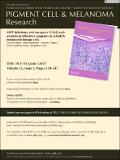| dc.contributor.author | Phelps, Grace B | |
| dc.contributor.author | Amsterdam, Adam | |
| dc.contributor.author | Hagen, Hannah R | |
| dc.contributor.author | García, Nicole Zambrana | |
| dc.contributor.author | Lees, Jacqueline A | |
| dc.date.accessioned | 2022-09-16T15:06:09Z | |
| dc.date.available | 2022-09-16T15:06:09Z | |
| dc.date.issued | 2022-09 | |
| dc.identifier.uri | https://hdl.handle.net/1721.1/145461 | |
| dc.description.abstract | Uveal melanoma (UM) is the most common primary malignancy of the adult eye but lacks any FDA-approved therapy for the deadly metastatic disease. Thus, there is a great need to dissect the driving mechanisms for UM and develop strategies to evaluate potential therapeutics. Using an autochthonous zebrafish model, we previously identified MITF, the master melanocyte transcription factor, as a tumor suppressor in GNAQQ209L -driven UM. Here, we show that zebrafish mitfa-deficient GNAQQ209L -driven tumors significantly up-regulate neural crest markers, and that higher expression of a melanoma-associated neural crest signature correlates with poor UM patient survival. We further determined how the mitfa-null state, as well as expression of GNAQQ209L , YAPS127A;S381A , or BRAFV600E oncogenes, impacts melanocyte lineage cells before they acquire the transformed state. Specifically, examination 5 days post-fertilization showed that mitfa-deficiency is sufficient to up-regulate pigment progenitor and neural crest markers, while GNAQQ209L expression promotes a proliferative phenotype that is further enhanced by YAPS127A;S381A co-expression. Finally, we show that this oncogene-induced proliferative phenotype can be used to screen chemical inhibitors for their efficacy against the UM pathway. Overall, this study establishes that a neural crest signature correlates with poor UM survival, and describes an in vivo assay for preclinical trials of potential UM therapeutics. | en_US |
| dc.language.iso | en | |
| dc.publisher | Wiley | en_US |
| dc.relation.isversionof | 10.1111/pcmr.13057 | en_US |
| dc.rights | Creative Commons Attribution NonCommercial License 4.0 | en_US |
| dc.rights.uri | https://creativecommons.org/licenses/by-nc/4.0/ | en_US |
| dc.source | Wiley | en_US |
| dc.title | MITF deficiency and oncogenic GNAQ each promote proliferation programs in zebrafish melanocyte lineage cells | en_US |
| dc.type | Article | en_US |
| dc.identifier.citation | Phelps, G. B., Amsterdam, A., Hagen, H. R., García, N. Z., & Lees, J. A. (2022). MITF deficiency and oncogenic GNAQ each promote proliferation programs in zebrafish melanocyte lineage cells. Pigment Cell & Melanoma Research, 35, 539–547 | en_US |
| dc.contributor.department | Massachusetts Institute of Technology. Department of Biology | en_US |
| dc.contributor.department | Koch Institute for Integrative Cancer Research at MIT | en_US |
| dc.relation.journal | Pigment Cell & Melanoma Research | en_US |
| dc.eprint.version | Final published version | en_US |
| dc.type.uri | http://purl.org/eprint/type/JournalArticle | en_US |
| eprint.status | http://purl.org/eprint/status/PeerReviewed | en_US |
| dc.date.updated | 2022-09-16T14:58:51Z | |
| dspace.orderedauthors | Phelps, GB; Amsterdam, A; Hagen, HR; García, NZ; Lees, JA | en_US |
| dspace.date.submission | 2022-09-16T14:58:54Z | |
| mit.journal.volume | 35 | en_US |
| mit.journal.issue | 5 | en_US |
| mit.license | PUBLISHER_CC | |
| mit.metadata.status | Authority Work and Publication Information Needed | en_US |
